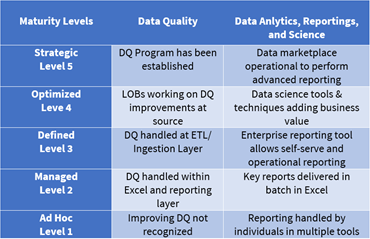Elevating Your Game
Data Analytics
Analytics, as we know it, has had quite the revolution in the Digital Age. Analytics is a broad term and has a multitude of applications and definitions within industries of all types and companies of all sizes. An important consideration when it comes to digital, no matter where you are in your analytics journey is… How can analytics enable growth?
Profitable growth is a key element to increasing company value, and in today’s climate, fast-growing companies are more prevalent as they’re increasing competitive pressures. Leveraging data analytics will enable your company to grow and achieve its growth targets more quickly and profitably. However, getting started is often the most challenging part. How do we decide which analytics are the most meaningful? Where do we get the data… how do we calculate… how do we operationalize… how do we analyze? Who is the audience and how do we make it easy for them to consume its results or enable them to build their own data tools? Many questions surface and there is much to consider.
The best place to start is with an overall assessment of your current state in the area of Business Intelligence (Reporting and Analytics). To assess an organization’s maturity level, we examine two key areas… the quality of the data and the mechanisms for Data Analytics, Reporting, and Science. The following chart describes the criteria used to evaluate maturity level.
Measuring Your Current Maturity Level
 Evaluation steps:
Evaluation steps:- Take a fully objective and independent approach.
- Organize and lead a 1-2 session Workshop.
- Include participants from all business lines (Data SMEs).
- Involve relevant IT experts (Network, Support, BI, Application and Systems Analysts).
- Gain alignment and score each area with consensus.
- Plot future state (12 – 18 Month Timeline).
- Document expected outcomes and activities that would achieve your realistic future state
Once your level of maturity is understood, activities and projects needed to elevate maturity can then be charted. Further, it is important to define Key Performance Indicators (KPIs) in order to track progress and measure business impact along your growth path. These KPIs should be derived at the corporate level and target success factors and growth. Propagate the KPIs down to the various lines of business. These are important to get right and the data used to build them must be accurate and credible. Performing an internal assessment, as shown in the high-level example above, will help you in your journey.
Deeper Dive into Analytics Types
Another way to think about your level of analytics maturity is to consider what your current analytics allow you to do today or how they might serve as barriers. One view of this is shown below, in a Gartner-developed pyramid model. Understanding how your organization would leverage analytics is an important component to defining future state and the path to take. Making strategic investments in infrastructure, and software while scaling your delivery methodologies, can accelerate the path to your desired level.

Consider the following definitions for each step below:
Descriptive Analytics: A form of advanced analytics that examines data or content to answer the question, “Why did it happen?” It is characterized by techniques such as drill-down, data discovery, data mining and correlations.
Diagnostic Analytics: The examination of data or content, usually manually performed, to answer the question “What happened?” (or What is happening?), characterized by traditional business intelligence (BI) and visualizations such as pie charts, bar charts, line graphs, tables, or generated narratives.
Predictive Analytics: A form of advanced analytics which examines data or content to answer the question “What is going to happen?” or more precisely, “What is likely to happen?”, and is characterized by techniques such as regression analysis, forecasting, multivariate statistics, pattern matching, predictive modeling, and forecasting.
Prescriptive Analytics: A form of advanced analytics which examines data or content to answer the question “What should be done?” or “What can we do to make “X” happen?”, and is characterized by techniques such as graph analysis, simulation, complex event processing, neural networks, recommendation engines, heuristics, and machine learning.
Conclusion
As you consider your plans for evolving and maturing your analytics capabilities, it is important to formulate a data strategy and plan. Take the first step. Understand your level of maturity and capabilities. Determine the future state. Baseline your path with KPIs. Then, tackle a small project to ensure you can demonstrate success… Learn, adjust, and advance. Rinse and repeat. Establish a new baseline as you achieve success and targets. You will be pleased at the return and the results you see. And of course, consider reaching out to Vaco for advise or navigation.
Brian Henn
Brian Henn is a proven IT and business enabling leader who has oversight for Vaco’s Cincinnati delivery within all technology services, as well as serving as the Data Practice Director. With over 20 years of IT consulting and 5+ years of corporate experience, Brian has successfully implemented and built matured data practices and IT teams. He  brings a broad depth of experiences serving clients across many industry verticals helping them to think in innovative ways allowing data to help them achieve their corporate objectives. Brian is passionate about ensuring that projects are delivered with the highest degree of quality and working with clients with an eye toward strategic data management.
brings a broad depth of experiences serving clients across many industry verticals helping them to think in innovative ways allowing data to help them achieve their corporate objectives. Brian is passionate about ensuring that projects are delivered with the highest degree of quality and working with clients with an eye toward strategic data management.